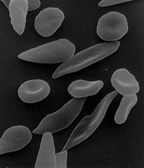Malaria Mystery: SOLVED
While scientists have long known that carriers for Sickle Cell Trait are more resistant to Malaria infection, the mechanism by which protection is conferred has not been well understood—until now. Scientists at Heidelberg University used an electron microscope to observe what happens when the parasite that causes Malaria in humans, Plasmodium falciparum, infects red blood cells containing both healthy and mutant hemoglobin.
Scientists noticed that in red blood cells with healthy hemoglobin, the parasite hijacks the actin cytoskeleton to transport its own “adhesin” protein to the cell membrane. The adhesin, also called Plasmodium falciparum Erythrocyte Membrane Protein 1 (PfEMP1), causes the red blood cells to adhere to each other and to the walls of small blood vessels so that the infected cells don’t circulate through the spleen, where they would otherwise be destroyed. The parasite continues to reproduce within the infected cells and causes cell lysis, destroying the red blood cells and releasing more Plasmodium into the blood stream. As a result, Malaria patients become severely anemic and suffer from symptoms related to insufficient oxygen delivery.
While mutant hemoglobin polymerizes into long rods and causes red blood cells to sickle dangerously in low oxygen conditions, it appears that in sufficient oxygen conditions the mutant protein prevents Plasmodium from borrowing the actin cytoskeleton to ferry adhesin to the cell surface. Without knobs of adhesin protein, infected cells travel to and are destroyed in the spleen so that patients do not suffer Malaria symptoms.
Each individual carries two copies of the information needed to make a protein. People with two mutated hemoglobin genes may be highly resistant to Malaria infection, but they also suffer from Sickle Cell Disease, in which abnormally shaped red blood cells clog blood vessels and cut off the blood supply to organs. People with one copy of the mutant hemoglobin gene, however, make both enough healthy protein to maintain red blood cell shape and enough mutant protein to interfere with Malaria infection.
| Print article | This entry was posted by Tedi Setton on December 15, 2011 at 5:21 pm, and is filed under DNA Interactive. Follow any responses to this post through RSS 2.0. You can leave a response or trackback from your own site. |

